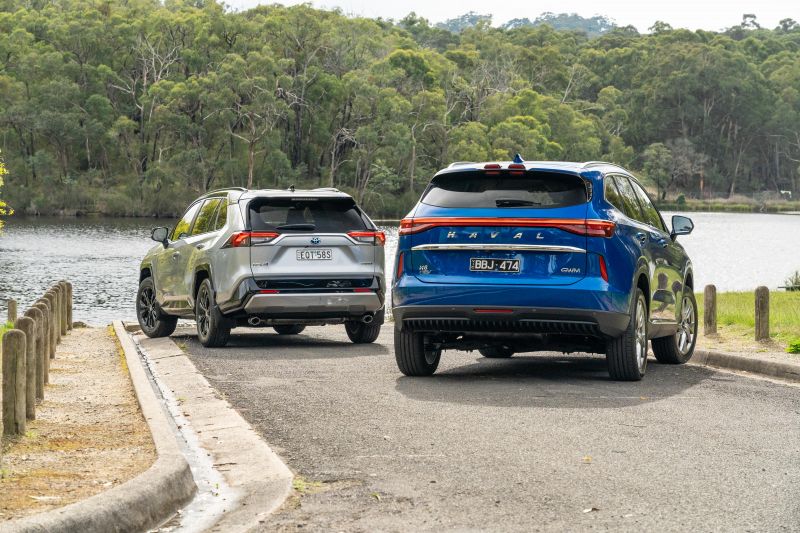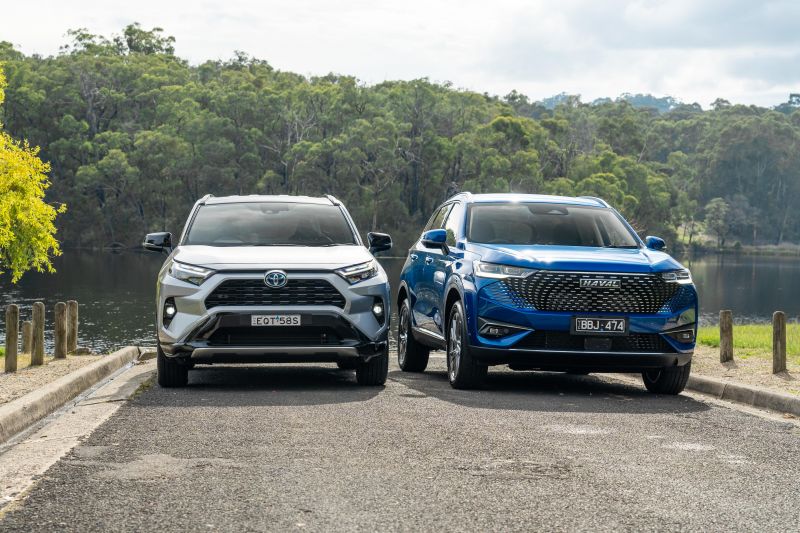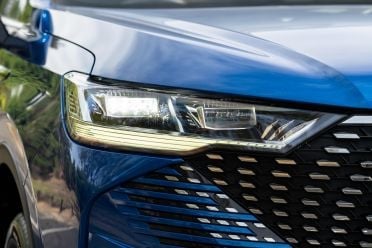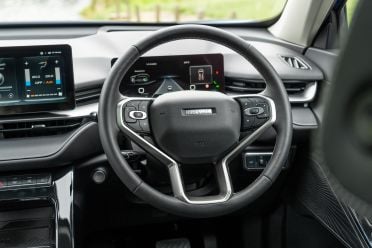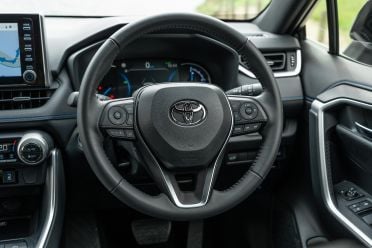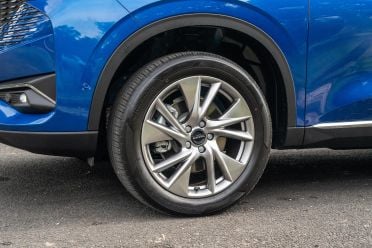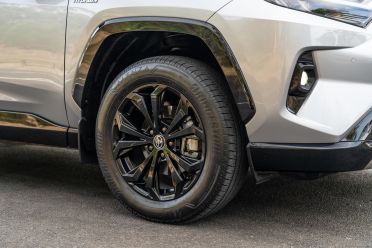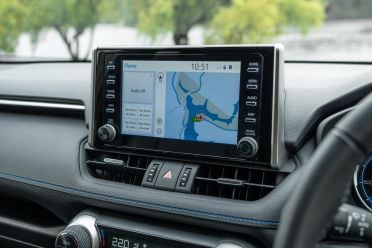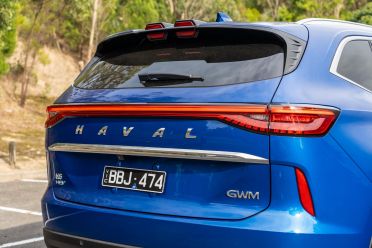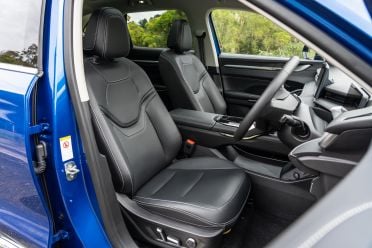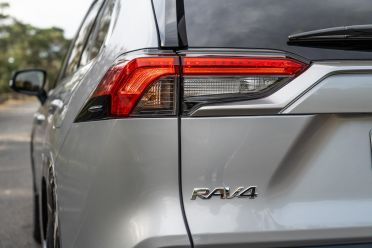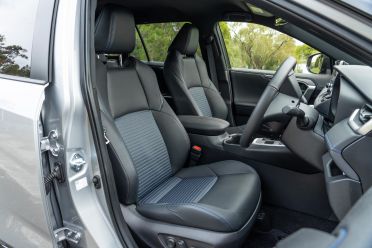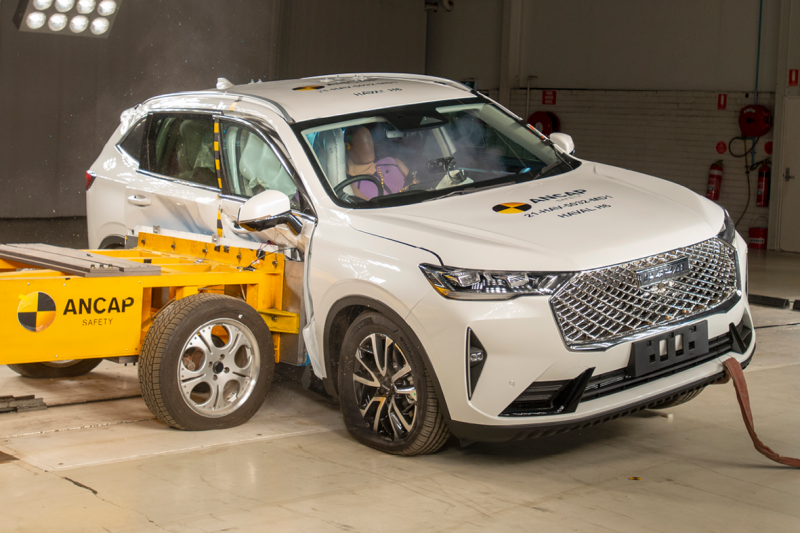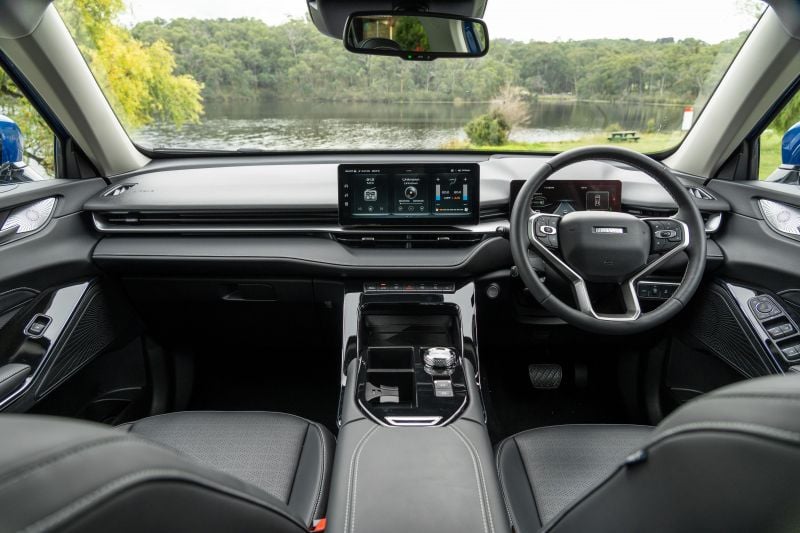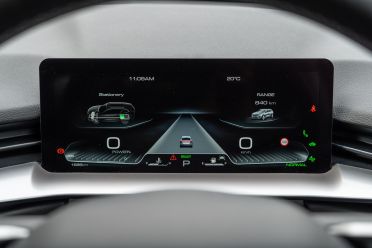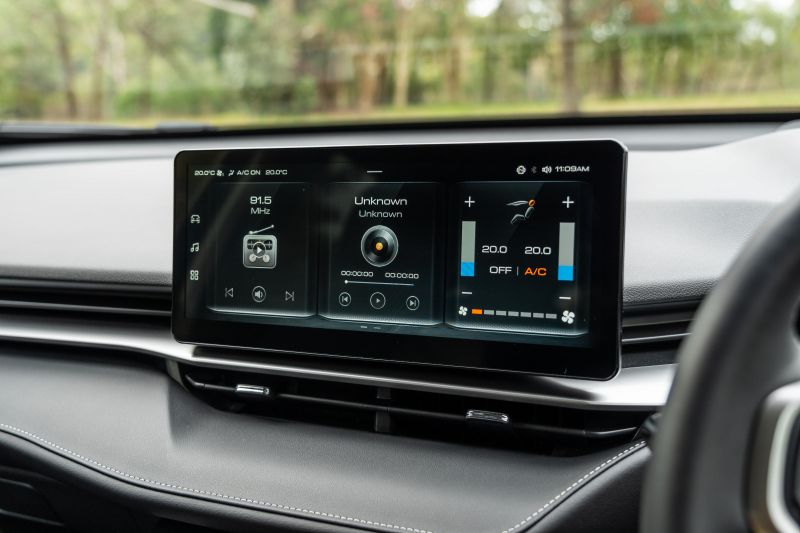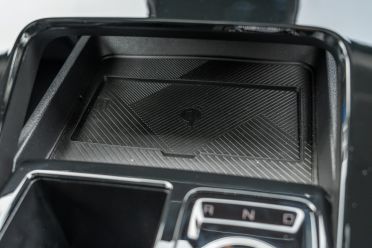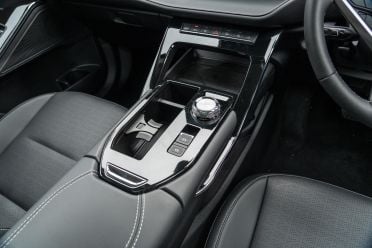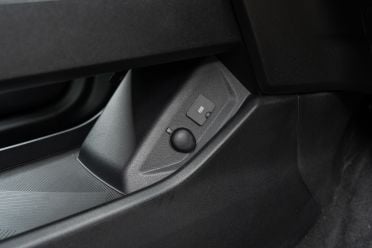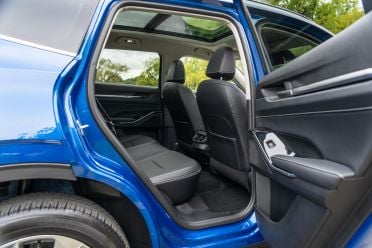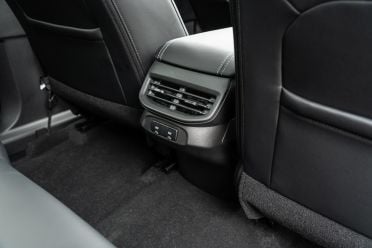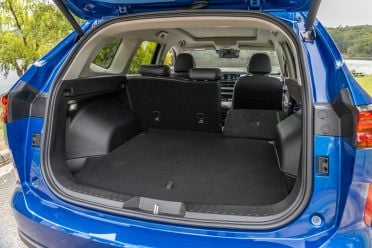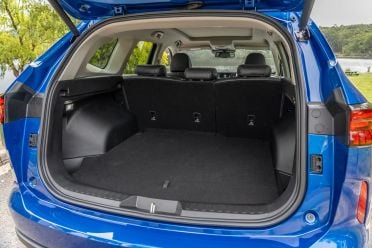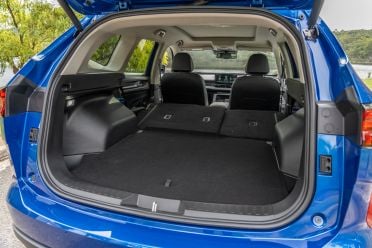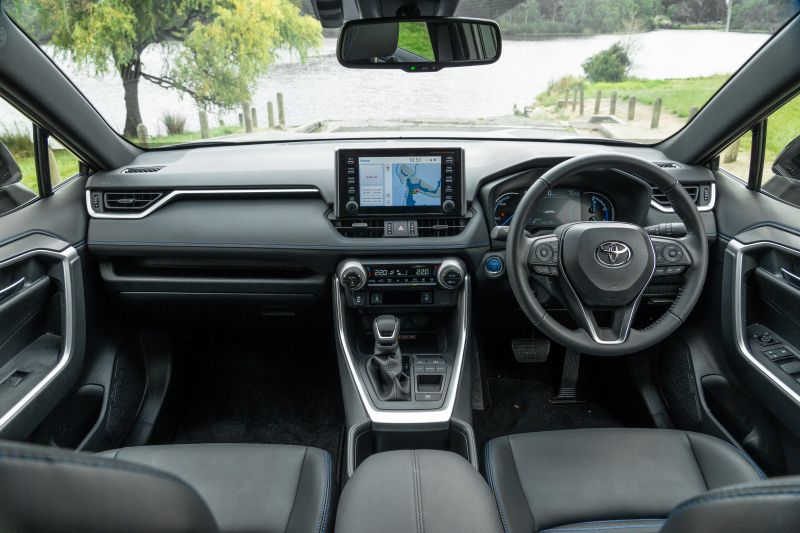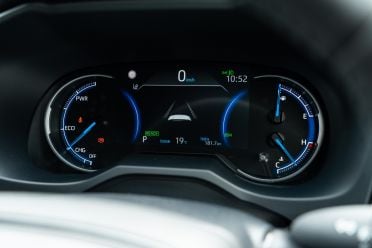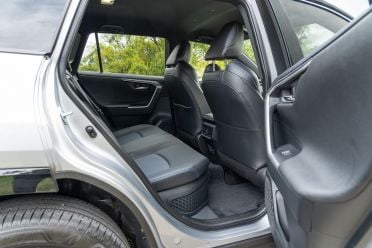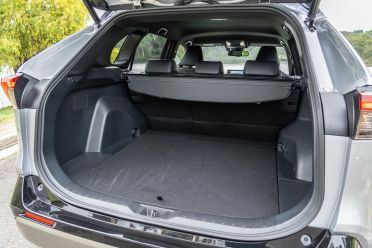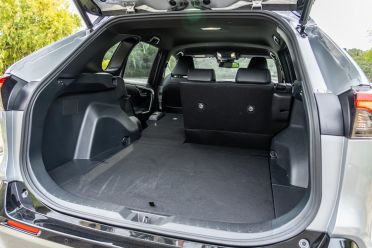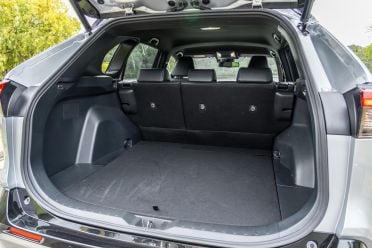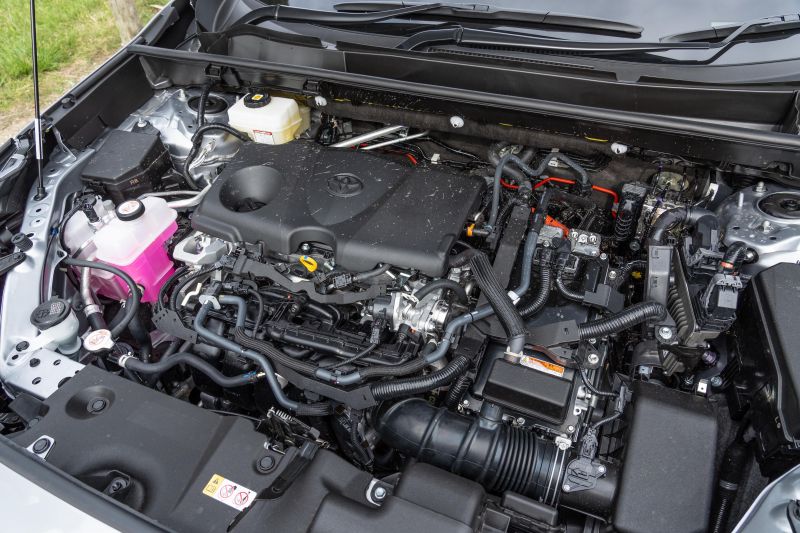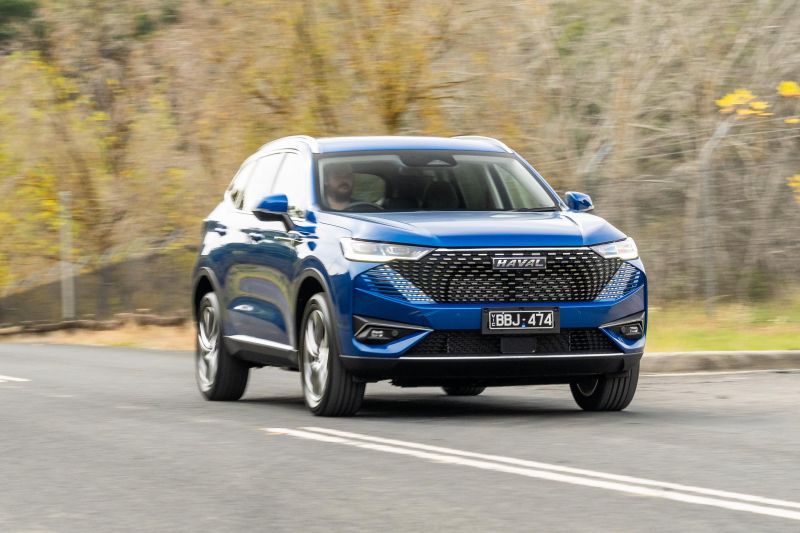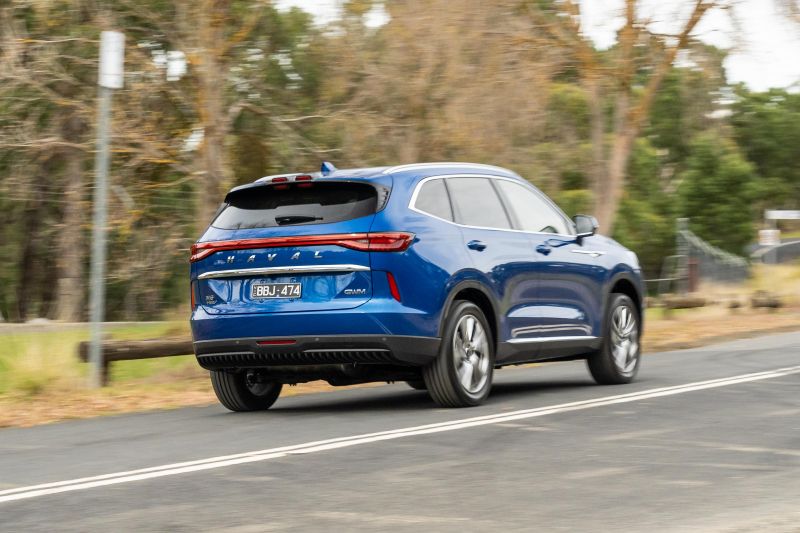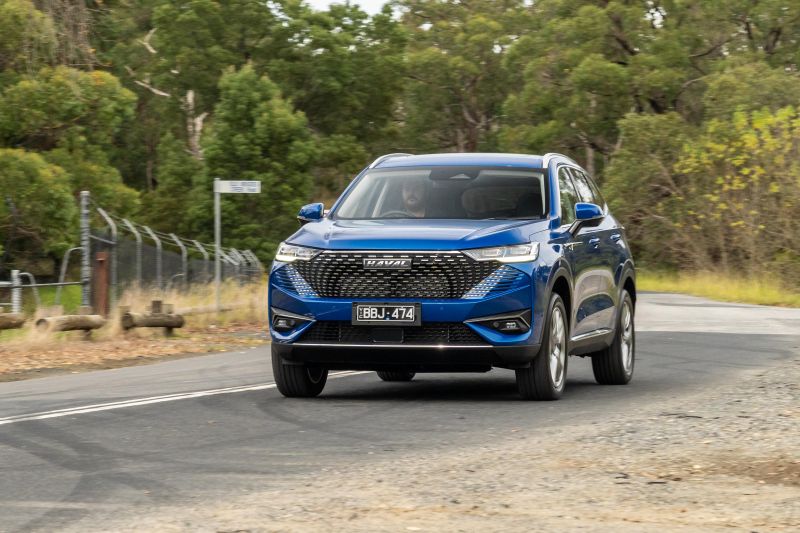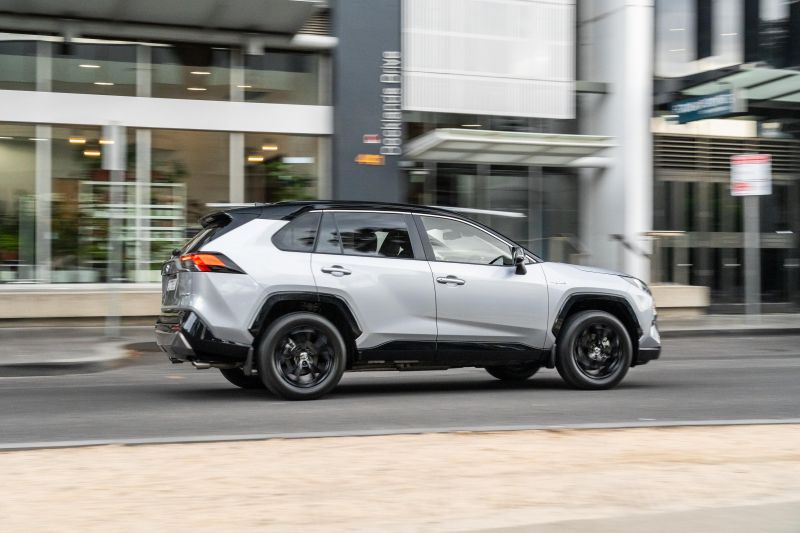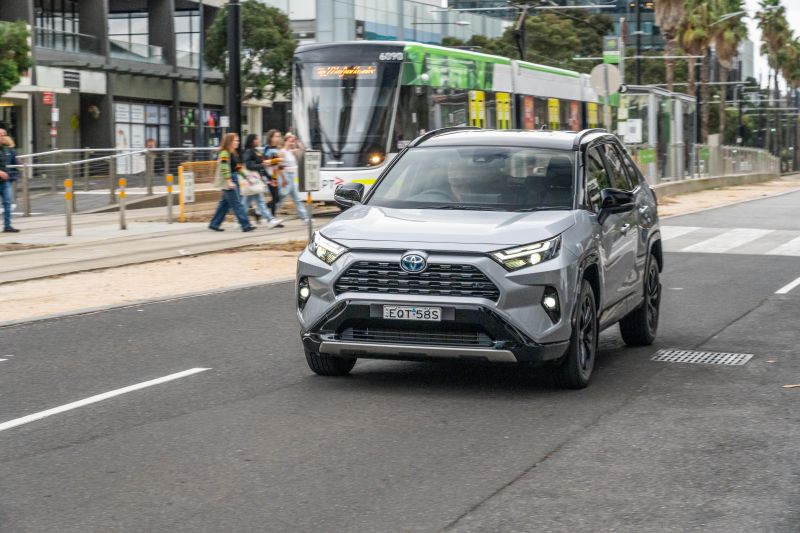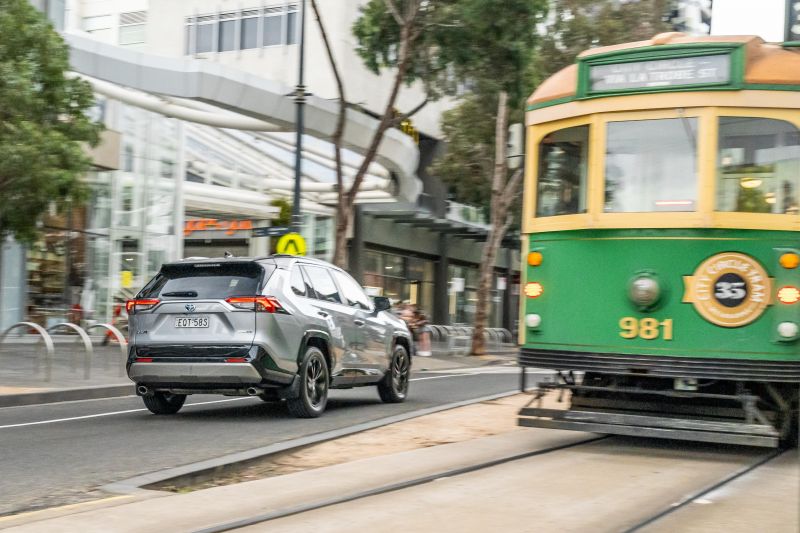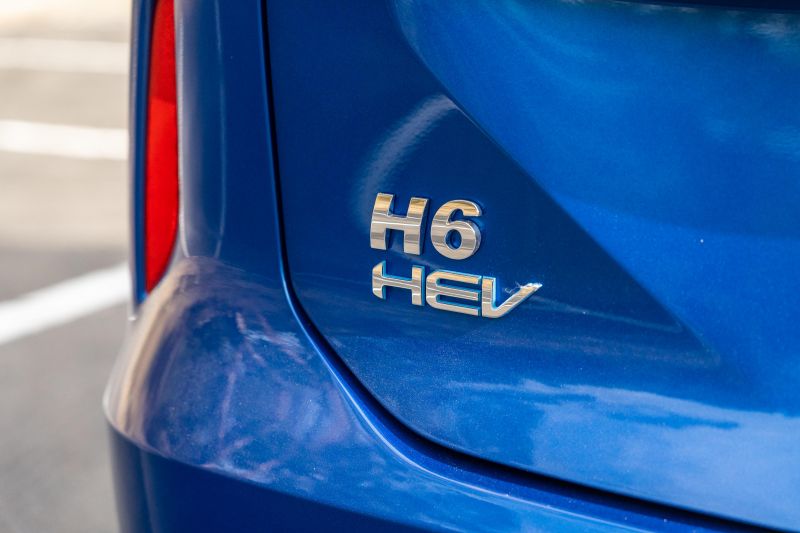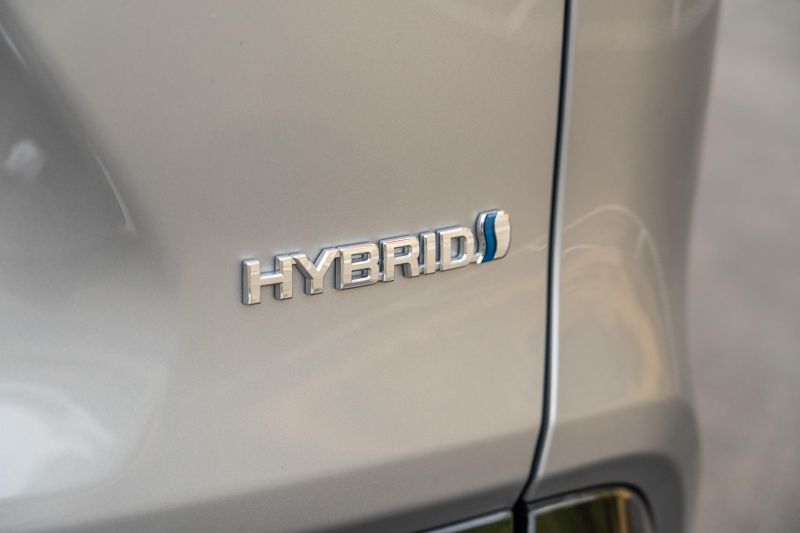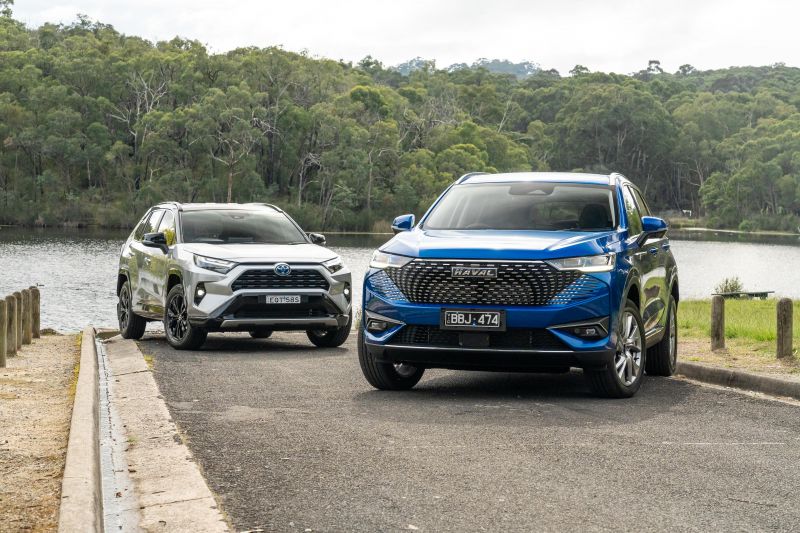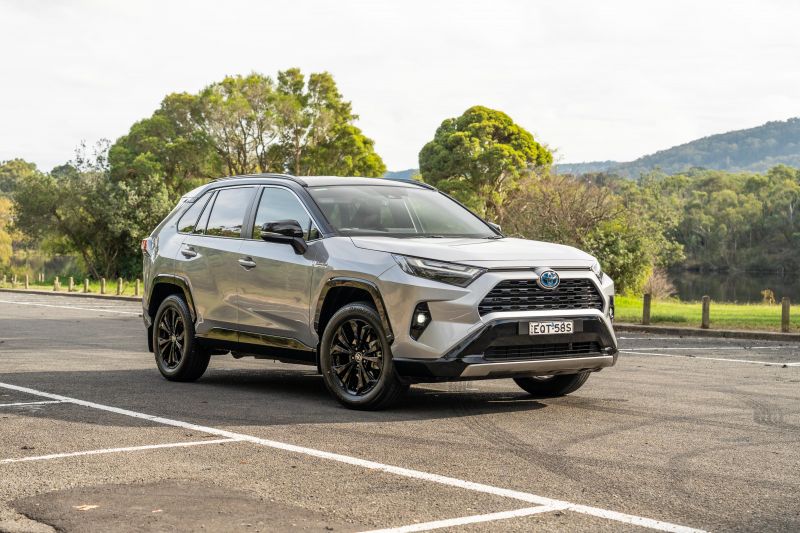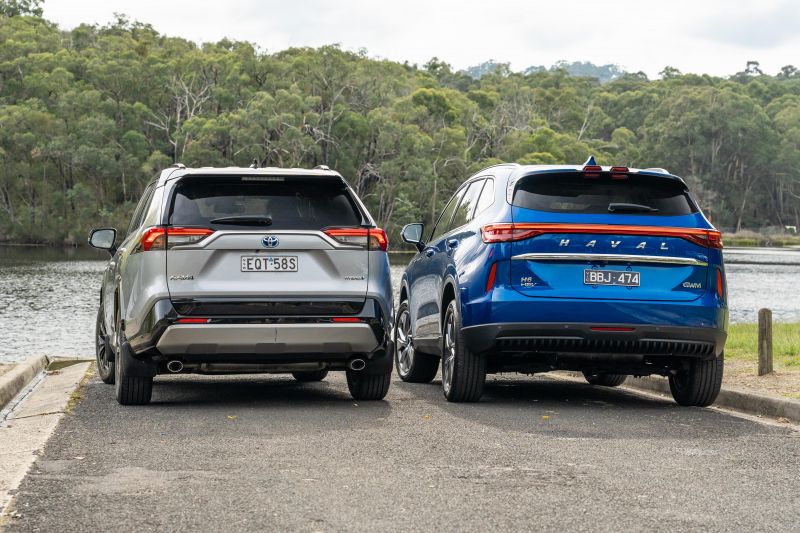The Toyota RAV4 is not only Australia’s reigning SUV sales champion, it’s also been a key driver of electrified vehicle uptake.
As with the Camry and Corolla, an overwhelming majority of buyers opt for the fuel-saving hybrid RAV4 option almost to its own detriment – we’ve heard of quoted wait times between 12 and 18 months depending on specification.
So, you’d think now is the perfect time for other manufacturers to strike, right? It may seem obvious, but very few have actually taken the leap.
The new 2022 Haval H6 Hybrid is one of only three proper hybrids in the class, one being the aforementioned RAV4, the other the Subaru Forester Hybrid which, let’s be honest, feels a little undercooked in terms of its fuel-saving abilities.
Haval and its GWM parent company have been experiencing steady uptick in Australia of late, with the standard H6 line-up in particular showing triple-figure growth in 2021 and right through 2022 thus far. A hybrid then, seems like a no-brainer.
On test we’ve lined-up the new H6 Hybrid against the 2022 Toyota RAV4 XSE 2WD Hybrid. The new variant for the MY22 RAV4 line-up is smack bang in the middle of the range, and offers competitive levels of specification to the Haval, though is almost $2000 dearer.
Should you stick with the segment leader? Or should you take a chance on China’s new entrant? Let’s find out.
How much?
The 2022 Haval H6 Hybrid – or H6 Ultra Hybrid – is priced from $45,990 drive-away. It carries a $5000 premium over the petrol-powered H6 Ultra FWD with which it shares just about all of its specification bar the drivetrain.
Meanwhile, the 2022 Toyota RAV4 XSE 2WD Hybrid lists for $43,250 plus on-road costs, which according to the brand’s online configurator equates to about $47,928 drive-away using a Victorian postcode.
Right off the bat, the Haval gets a $2000 head start in the pricing stakes, though despite its flagship status there are some features the H6 lacks compared to the RAV4, and vice versa. You can also opt for an all-wheel drive hybrid version of the RAV4 which adds $3000 (from $46,250).
It’s worth noting that both vehicles you see here feature premium paint finishes, which adds $495 in the case of the H6’s lovely Sapphire Blue metallic, and $675 for the RAV4’s Silver Sky metallic.
What do you get?
It’s worth noting that the H6 Hybrid is solely available in flagship Ultra trim, whereas the equivalently-priced RAV4 XSE 2WD Hybrid is effectively a mid-spec grade, with cheaper and more expensive options either side of it, offering more or fewer features.
Both vehicles here have fulsome standard active safety technology suites, automatic LED headlights with LED fog lights, alloy wheels, leatherette seat trim, electric driver’s seat adjustment, along with touchscreen infotainment systems with wired Apple CarPlay and Android Auto.
Other common features include rear privacy glass, auto-dimming rear-view mirrors, heated front seats, keyless entry with push-button start, as well as powered tailgates.
The Haval scores bigger 19-inch alloy wheels, a larger 12.3-inch touchscreen (compared to 8.0 inches in the Toyota) as well as a fully digital 10.25-inch instrument cluster display, a semi-autonomous parking assistant, four-way powered front passenger seat (versus manual adjustment in the RAV4 XSE), ventilated front seats, and a surround camera system with 3D view function.
Meanwhile, the Toyota counters with native satellite navigation, DAB+ digital radio, as well as contrast black exterior accents for the roof, mirror caps and alloy wheels.
Worth noting is the fact that if you order a new RAV4 today, you’ll potentially get an upgraded model due later this year which should bring a new infotainment system, net-based connected services, a fully digital instrument cluster as well as some additional safety features. Read more about that here.
The Haval appears to be the better-equipped car on paper, as it should given its flagship status. However, the RAV4 inclusions like embedded satellite navigation and DAB radio which should be a given at this end of the market.
Also working in favour for the Toyota, as we’ll get to in a bit, is a layer of polish that the Haval doesn’t match – showcasing the Chinese brand’s youth and also a level of attention to detail and experience employed by the Japanese giant.
For an extra $2500 you can also step up to the RAV4 Cruiser Hybrid, which if you can wait the current 18-month quoted delivery time gets you a long list of extra equipment that basically makes it a match for the Haval for not much more coin.
Depending on how important this stuff is to you, the Haval wins in the value category on paper.
Are they safe?
Haval H6
The H6 wears a 2022-stamped five-star ANCAP safety rating based on tests conducted in Australia against the latest, strictest crash testing criteria. As of June 16, 2022, this rating has been extended to include the H6 Hybrid and upcoming H6 GT models.
It managed 90 per cent for adult occupant protection, 88 per cent for child occupant protection, 73 per cent for vulnerable road user protection and 81 per cent for safety assist.
Safety features include:
- Autonomous emergency braking (AEB)
- Pedestrian and Cyclist detection
- Junction assist
- Forward collision warning
- Lane departure warning
- Lane-keep assist
- Lane centring assist
- Adaptive cruise control with stop/go
- Traffic Jam Assist
- Blind-spot monitoring
- Rear cross-traffic assist
- Driver attention monitoring
- Safe exit warning
- Traffic sign recognition
- Front and rear parking sensors
- 360-degree camera system
- Tyre pressure monitoring
- 7 airbags incl. front-centre inflator
Toyota RAV4
The Toyota RAV4 wears a five-star ANCAP safety rating based on tests conducted in 2019.
It scored of 93 per cent for adult occupant protection, 89 per cent for child occupant protection, 85 per cent for vulnerable road user protection, and 83 per cent for safety assist.
Standard safety features across the range include:
- Autonomous emergency braking (AEB)
- Pedestrian detection (day/night)
- Cyclist detection (day)
- Blind-spot monitoring
- Rear cross-traffic alert
- Lane departure warning
- Lane Tracing Assist
- Reversing camera
- Front and rear parking sensors
- Adaptive cruise control
- Traffic sign recognition
- Trailer sway control
- 7 airbags incl. driver’s knee
What are they like inside?
Haval H6
The top-spec H6’s cabin presents well on first glance, with fake leather lining most surfaces, large high-resolution displays, and a minimalistic approach to physical switchgear.
It certainly shows just how far the Chinese brands have come in such a short time. I remember the previous-generation Haval H6 looking and feeling like an imitation of a Mk5 Golf-era Volkswagen despite hitting the market almost 10 years later.
Hop in the driver’s seat and you’ll almost immediately notice the awkward positioning relative to the steering wheel. I typically like a low seating position, but the van-like upward-facing steering wheel placement and oddly shaped driver’s seat mean it’s quite difficult to get comfortable – something echoed by some colleagues.
Raising the seat base with a more upright backrest seemed to make it a little more bearable for my long-legged 6’1 frame, though I did feel as if I was forcing myself into the seat base and after longer drives would feel some soreness under the thigh and glutes.
Behind the steering wheel is a free-standing 10.25-inch digital instrument cluster that takes a more futuristic layout with fairly limited configurability. You can toggle the readouts on either side using the steering wheel buttons, but it lacks the personalisation and pizazz of something like Volkswagen’s Digital Cockpit.
Material quality generally feels pretty good, with the aforementioned leatherette surfaces complemented by soft-touch plastics and gloss black trim for a classy and clean look – mind the fingerprints – and everything feels very well screwed together. Again, the Chinese brands have come a long way.
The 12.3-inch central touchscreen runs the infotainment system and also acts as the control centre for the HVAC controls.
If you leave the native interface running with your phone connected via Bluetooth it works fine, although is quite basic. If you plug your phone in via USB for Apple CarPlay or Android Auto, you need to exit the smartphone mirroring to access the climate controls.
While changing the temperature isn’t something you need to constantly be adjusting, the air recirculation function is buried in this touchscreen menu, though thankfully the front and rear de-misters are physical buttons on the centre stack.
There’s decent storage about too, with modular cupholders, a shelf for your phone with a built-in wireless phone charger, a hidden cubby under the centre tunnel, as well as a deep bin under the padded and stitched centre armrest.
It also has good-size door pockets that can fit regular bottles, so most of your odds and ends have somewhere to go.
Moving to the rear, the Haval H6 really starts to shine. It’s easily one of the most spacious second-row seats in the segment, and will appeal to growing families with lanky teenagers or those that have to cart taller friends often.
I fit more than comfortably behind my driving position, and there’s good width so you can seat three abreast in decent comfort. The flat centre seat cushion and minimal centre tunnel hump help this.
Rear amenities include directional air vents, two USB charge points, map pockets behind both front seats, bottle holders in the doors, as well as a fold-down centre armrest with extra cupholders.
Kids are catered for with ISOFIX anchors on the outboard seats, as well as top-tether points across all three rear positions.
Behind those rear seats is the larger of the two boot areas on test. Haval quotes 600 litres with the second row in use, expanding to 1485L with them folded.
It’s a nice square load area, and when the rear seats are folded it’s a relatively flat surface which helps stow longer, heavier items. Unfortunately there’s no remote releases for the second row in the boot area.
Haval doesn’t fit a spare wheel of any kind under the boot floor of the H6 Hybrid, instead offering a tyre repair kit. Non-hybrid versions of the H6 get a space-saver spare.
Toyota RAV4
The RAV4’s interior continues to be well presented with sound ergonomics and solid build quality, even if the dark colour scheme and average display quality may pale compared to some rivals.
Everything just seems to work as it should, with the electrically-adjustable driver’s seat well positioned for a variety of body types, clear instrumentation and a more conventional approach to physical switchgear that sees key functions remaining as actual buttons that are well within reach.
In the new XSE variant, the swathes of leatherette – used on the seats, dashboard and doors – features eye-catching blue stitching and accent elements that add a pop of colour. Even so, the grained door and dashboard bits look a little meh and are perhaps less visually polished than the surfaces in the Haval.
The driver is faced with a compact, nicely designed steering wheel and a partially-digitised instrument cluster with analogue gauges for the hybrid power meter, fuel level and temperature.
It’s worth noting that Toyota is introducing a range of upgrades to the RAV4 line later this year, and higher grades are expected to score a new 12.3-inch digital instrument cluster which should really spruce up the interior.
The current unit is fine though, with a variety of menus and readouts available to the driver and well-thought graphics that make accessing information simple. Everything is legible and logically positioned. You can also switch in a virtual speedometer dial.
Sitting atop the dashboard is an 8.0-inch freestanding touchscreen which features native satellite navigation, wired Apple CarPlay and Android Auto, as well as DAB digital radio functionality.
While the display size and resolution can’t match that of the H6, having native mapping as well as digital radio are key points of difference that will find favour with numerous potential buyer demographics. Further, there are physical buttons on each side of the screen for quick access to various functions and menus.
It works well enough, with more logical menus and less of a learning curve for main functions, particularly given the climate controls aren’t buried in the display, but load times can at times be laggy and the clarity of the graphics is feeling old-hat.
Again, the updated range due later this year should bring a new infotainment display to complement the available digital instrument cluster, which should make the RAV4 more competitive if we get the larger 10.5-inch display offered overseas, Down Under.
The RAV4 offers above-average rear passenger accommodation for the segment, if not being quite as spacious as its Chinese rival in this test.
Leg and knee room is good even behind a taller driver, and headroom is excellent. Two adults should be more than comfortable back there, and you could sit three across for shorter distances just fine. Like the Haval, the middle seat is fairly flat and there’s only a small centre hump, to maximise space.
There are rear air vents, USB charge ports, bottle holders in the doors, a fold-down centre armrest with cupholders, as well as a single map pocket behind the front passenger’s seat.
Like the H6, the RAV4 features ISOFIX anchor points for both outboard seating positions, and there are top-tether points across all three rear seats.
Toyota quotes two boot volumes for the RAV4, with 542L available when the floor is set to the higher level (allowing for a flat load bay when the rear seats are folded) upping to 580L when it its lower position.
Oddly, there’s no figure in the Australian spec sheet for when the rear seats are folded, but we can confirm that it’s large, flat, and more than a match for the Haval if you’re wanting to carry longer items like furniture, bikes, camping gear and the like.
There’s a space-saver spare wheel under the boot floor, arguably a big win over the Haval, though the XSE variant isn’t available with an optional full-size spare like the entry-level GX AWD Hybrid.
While the Haval has more stuff, more space and glitzier displays, the RAV4 wins the interior category for overall comfort, ease of use, and familiarity.
What’s under the bonnet?
Haval H6
Power in the H6 Hybrid comes from a 110kW/230Nm 1.5-litre turbocharged petrol engine teamed with a 130kW two-speed electric motor and battery pack.
System outputs are quoted at 179kW and 530Nm, though Haval doesn’t specify where in the rev range these peaks come online.
Drive is sent exclusively to the front wheels only, with a two-speed ‘Direct Hybrid Transmission’, capable of using the petrol engine to power the battery and having the electric motor drive the wheels, using the engine to drive the wheels directly, using the electric motor to drive the wheels directly, and having both power sources combine.
Haval claims the H6 Hybrid will use 5.2L/100km on the combined cycle, with 91 RON regular unleaded the rated minimum octane level. The 61L fuel tank capacity equates to a theoretical driving range of around 1173 kilometres.
Toyota RAV4
The RAV4 Hybrid features a 131kW/221Nm 2.5-litre petrol engine running the efficient Atkinson cycle, teamed with an 88kW/202Nm electric motor and battery.
System power is rated at a maximum 160kW in 2WD guise, with Toyota quoting separate torque outputs for the petrol engine (221Nm) and e-motor (202Nm) rather than a combined output. Opting for the eFour electric AWD version adds a rear axle electric motor, bumping system power to 163kW.
Toyota claims the RAV4 2WD Hybrid will use a combined 4.7L/100km, and can happily run on cheaper 91 RON unleaded in its 55-litre tank. Using those figures, the RAV4 should offer around 1170km of driving range – 3km less than the Haval’s theoretical figure.
How do they drive?
Haval H6
I wasn’t sure what to expect from the Haval, given I was a little underwhelmed by the drivetrain refinement in the H6 Lux FWD I tested some months ago.
The more energy dense lithium-ion battery (compared to the RAV4’s nickel-metal hydride pack) and more powerful electric motor means the Haval will often rely on its electrical components for better EV-style driving capability.
Compared to the Toyota, the Haval is able to get up to higher speeds from take-off using just the electric motor, and you don’t have to be the gentlest of gentle on the throttle to avoid awakening the petrol motor.
When said petrol engine does fire up and assist the electrified bits, there’s good insulation from vibration and noise, and it feels like the Haval’s drivetrain is better at shuffling between power sources for more linear acceleration. Having a turbocharger means there’s more engine torque down low.
The petrol engine is also less vocal under load than the Toyota’s, and if you hoof it away from the lights the quoted 520Nm of combined torque is gradually put down to avoid lighting up the front tyres too much. I was actually quite impressed on the couple of occasions I really floored it that the FWD-only Haval got along nicely.
On the move the cabin feels more hushed and the suspension tune is tuned more for comfort. That also translates to a tall, lean-happy feeling in the bends if you throw the Haval at some corners, but that’s not really the intended purpose here.
What’s really a shame is that driving position; I couldn’t really find a comfortable driving setup for a longer trip, and this was a common complaint amongst the CarExpert team.
The Haval H6 feels like a big, high-riding SUV from behind the wheel, from the perceived width and length to the driver controls and feeling of solidity at speed.
For those who like that big-car feel, this will be a plus. For those perhaps wary of moving into an SUV who prefer the more athletic feel of a passenger car, it’s something to think about.
The H6 Hybrid is softly sprung and the driver controls are pretty light. It’s all calibrated to be driven smoothly and efficiently with a focus on comfort.
It mostly delivers on this too, irrespective of my issues with the driving position. The Chinese SUV impresses with its acceptably polished and refined on-road experience.
Less impressive is the Haval’s driver assistance suite, with the same quirks I experienced in the H6 Lux coming to the fore again – though it’s better than the systems in the smaller Haval Jolion.
The adaptive cruise and lane centring functions should make for semi-autonomous highway driving but are far too sensitive and have a habit of over-assisting. I often found myself taking over and doing the full job myself which is something I usually don’t have to do these days.
Blind-spot monitoring and rear cross-traffic alert functions are more competitive with rival systems, however, and the excellent surround camera system offers benchmark clarity on the high-resolution 12.3-inch central display. You shouldn’t have any issues parking this thing.
The rotary shift-by-wire control does, however, take a bit of getting used to and can often be fiddly when trying to do something a like a three-point turn. Not a dealbreaker, but worth highlighting so you can keep a keen eye out for it if you take the Haval for a test drive.
Overall though, a very solid effort from the Chinese challenger.
Toyota RAV4 Hybrid
Having spent time in a number of RAV4 Hybrids since this generation launched in 2019, the new XSE variant of Australia’s most popular SUV offers few surprises.
The 2.5-litre hybrid system in the RAV4 is tried and tested, with versions of the same drivetrain featuring in a range of other Toyota and Lexus models. It offers good performance and benchmark real-world fuel efficiency.
Power delivery is quite linear thanks to the well-calibrated powertrain management that sets off with the electric motor and then lets the petrol motor dial in as the speed or throttle input increases.
If you’re feather-light on the throttle on flat ground you can get to about 40km/h without firing up the petrol engine, though it feels as if the motor and nickel-metal-hydride battery aren’t as powerful nor energy dense as the Haval’s.
What does that mean? Well you’ll notice the RAV4 relies less on the electric motor under acceleration, though it will basically switch straight into EV mode once you’re off the throttle.
The clever Atkinson cycle petrol engine is also more efficient than the Haval according to trip computer readouts, which showed a half-a-litre lead over its Chinese counterpart.
One thing you’ll notice is that the petrol engine can get a bit rumbly and noisy under load, and it doesn’t feel quite as punchy as the 160kW system output quote suggests – you won’t be beating a Ford Escape or VW Tiguan 162TSI from the lights in this.
Ride and handling are highlights, however. The RAV4 strikes an almost perfect balance between comfort and dynamic engagement, with supple rebound and body control ironing out urban roads and rail crossings while fluid, accurate steering makes the front end feel keen and direct.
There’s a great degree of consistency and accuracy to how this vehicle drives, helping it to shrink around you and also meaning it’s a bit of fun. It’s no wonder so many Australians have fallen in love with the RAV4 as well as other TNGA-based Toyota products.
On the open road the RAV4 is nicely settled and offers great stability and road holding, and the hybrid powertrain does a good job at humming away in the background. Occasionally you’ll see it dip into EV mode as well.
You will notice a little more road noise in the RAV4 compared to the Haval in our experience, another slight knock in the refinement category for the Toyota.
Toyota’s latest generation of assistance features are well-calibrated, particularly compared to previous iterations, with systems like adaptive cruise control, Lane Tracing Assist (centring), blind-spot monitoring and rear cross-traffic alert all coming in handy in real-world scenarios.
Unlike the Haval you won’t find yourself wrestling the steering wheel as often or taking over from the adaptive cruise because it’s randomly slowing down. Everything works the way it says on the tin.
While the H6 Hybrid beats the RAV4 Hybrid in select areas like powertrain refinement and noise insulation on the move, the RAV4 arguably offers the more well-rounded experience and is more engaging to drive.
Cost of ownership
Haval H6
GWM Haval offers a seven-year, unlimited-kilometre warranty with five years of roadside assist.
The first service is required after 12 months or 10,000km – whichever comes first – but from there the intervals are 12 months or 15,000km. The first five years of servicing will set you back a combined $1650, or an average of $330 per annum.
In terms of real-world fuel consumption, we saw an indicated 6.5L/100km that didn’t really budge during our week of testing – 1.3L/100km up on the claim. With more urban driving, we did see real-time readings in the fives.
Using the 61-litre fuel tank as a reference, you could expect 938km of range from a fill (compared to the theoretical 1173km based on the manufacturer’s claim).
Toyota RAV4
The RAV4 is covered by Toyota’s five-year, unlimited-kilometre new vehicle warranty. The hybrid system’s battery is guaranteed for up to 10 years conditionally if regular servicing is maintained.
Service intervals are every 12 months or 15,000 kilometres, whichever comes first. Each visit is capped at $230 for the first five years, which is amongst the thriftiest in its segment.
As for real-world consumption, we saw an indicated 5.7L/100km which is 1.0L/100km up on the manufacturer’s claim but also 0.8L/100km better than the Haval’s efficiency on test. Both vehicles were tested on a mix of urban and highway roads.
With the 55-litre fuel tank in mind, you should be able to go 965km between fills, which is further than the Haval’s theoretical driving range based on real-world consumption.
The Haval has the longer warranty cover on paper, but Toyota’s leading dealer network coverage, cheap servicing and thriftier fuel economy give it the win in this round too.
CarExpert’s Pick
There’s no denying that the RAV4 Hybrid’s all-round performance, reputation for reliability and Toyota’s wide-reaching dealer network with cheap servicing is hard to beat.
While the Haval H6 Ultra Hybrid perhaps isn’t the better car on test, it does serve as arguably the most convincing competition for the Japanese top-seller we’ve seen in this market thus far – which can only be a good thing.
The Haval wins on driving refinement, a longer warranty, freshness of design and interior presentation, and is a little more spacious and practical for those who might need to carry adults or big pets often. It also has the more up-to-date safety rating.
Where it stumbles a little is driver comfort – the driver’s position irks me to no end – an attractive if somewhat confusing infotainment setup, and more expensive running costs (fuel economy and servicing).
Whereas the Toyota is a better hybrid in that it’s more fuel efficient, has a more cohesive suite of technology and ergonomics, and cheaper servicing costs.
It may not have the best infotainment unit or the most premium touches inside and out (upgrades are coming soon), but the RAV4 is a car you can get in for the first time, get comfortable with a couple of adjustments, and then be on your way.
The new XSE grade also strikes a good balance between pricing and features, and also shouldn’t be subject to the same insane wait times as its Cruiser stablemate (I’ve been hearing 18 months at the time of writing).
So the Toyota RAV4 XSE 2WD Hybrid wins this comparison, albeit not by a huge margin. If you can’t be bothered waiting for a RAV4 and you want a hybrid-powered SUV, the Haval could be worth a look.
Click the images for the full gallery
Videos
MORE: Everything Haval H6
MORE: Everything Toyota RAV4





